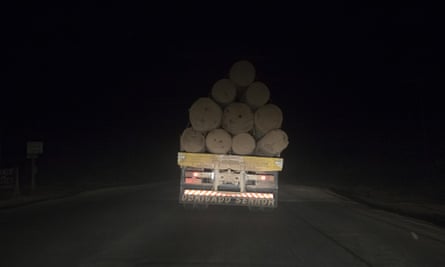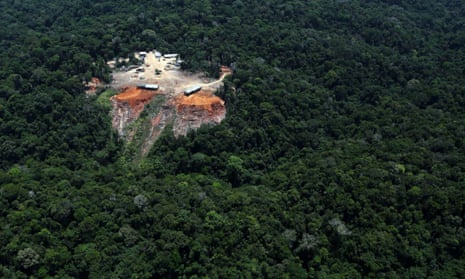Covert GPS surveillance of timber trucks by Amazon campaigners has revealed how loggers are defeating attempts to halt deforestation in the world’s greatest rainforest. Raids by law enforcement officers are expected early on Wednesday morning, acting on the evidence handed to them by Greenpeace Brazil.
The activists went undercover in the remote and dangerous state of Pará to secretly place GPS tracking devices on trucks suspected of illegal logging, the first time the tactic has been used. It revealed 200-mile-long journeys deep into protected regions of rainforest to collect logs and return journeys under the cover of night to sawmills in the Amazon port of Santarém, from where timber is exported to Europe, the US, China, and Japan. Satellite and aerial images were also collected and analysed during the hi-tech operation.
Violence has frequently accompanied attempts to expose illegal logging but the leader of the Greenpeace operation told the Guardian he had been determined to succeed.
“Everyone is afraid of something sometimes. But, even with fear, we wanted to expose that official papers are worth nothing in proving the legality of Amazon timber,” said the leader, who is Brazilian but requested anonymity. “We were convinced the operation would bring strong evidence of this silent crisis affecting the Amazon and its people.”
The Pará state Environment department (Sema) said in a statement: “Greenpeace’s research into timber companies transporting and receiving illegal timber demonstrates the necessity to improve the control and monitoring mechanisms to prevent illegal logging.” Sema said it had made major advances in recent years but still lacked the modern technology and resources it needed.
A fifth of the vast Amazon rainforest has been destroyed in the last three decades, leading to the murder of indigenous people and huge carbon emissions that are a significant contributor to climate change. Crackdowns by Brazil’s government had seen a falling trend over the last decade. But in 2013 deforestation increased by almost one-third, with environmentalists blaming a controversial weakening of legal protections passed by President Dilma Rousseff.
The covert operation began with two months of on-the-ground surveillance to identify the routines of the truckers, from where they ate and refuelled their vehicles to the river ferries and bridges they had to cross. In parallel, satellite images were cross-referenced with databases of logging permits to identify areas likely to harbour illegal tree felling.
Once the most promising targets had been identified, eight activists went undercover to deploy the magnetically-attached GPS trackers, using old cars to pass themselves off as travellers. “We were having lunch with truckers, getting the same ferries, even helping them to lift trucks from the mud,” said the team leader.
Attaching the trackers was tricky as, whilst only handheld in size, they need a clear line of sight to the sky to pick up the GPS signal. “The beacons had to be well-placed on the vehicle - hidden, but not so hidden so the signal was lost,” said the leader. “We had to work opportunistically, waiting for the best moments when the truckers were [distracted], talking to someone.”
Nine trackers were attached, generating thousands of GPS coordinates. Two trackers recorded particularly revealing journeys, while a small number appeared to have fallen off the truck and one was switched by the trucker on to a different unrelated vehicle. Small airplane flights were used to photograph the trucks waiting in the logging camp clearings.
Having established the forest trails used by the truckers, the activists then worked on the paper trail.
The logs, usually mahogany-like species such as jatobá, ipé, garapa and maçaranduba, came from state-owned parts of the rainforest, where no logging permits have been issued. They also found evidence suggesting the logs delivered to the sawmills were being laundered using permits from other areas. In May, another Greenpeace investigation claimed that illegally logged timber was being laundered on a massive and growing scale and then exported to unwitting buyers.

Pará state produces and exports more timber than any other in Brazil and data from figures from Imazon, a Brazilian NGO, suggests three-quarters of the wood shipped is illegally felled. “The current efforts to prevent illegal logging in the state forests are aimed at modernising licensing, control and supervision,” said Sema in its statement. It added that a new system using GPS “chips” to control, trace and confirm the origin of wood would be in place in the second half of 2015.
“For years, illegal loggers felt safe in the rainforest, far from the prying eyes of the world. Those days are over,” said Richard George, forest campaigner for Greenpeace UK. “As technology gets better, cheaper and smaller, it becomes easier for us to turn the tables and expose their crimes to the world.”
George said companies needed to consider whether to continue buying timber from the Amazon. “There are laws banning the trade in illegal timber in markets like the EU and the USA,” he said. “Companies trading in timber from the Amazon are taking a massive risk. Either they take responsibility for the wood they’re buying, making sure it’s been harvested legally and sustainably, or they stop buying from high-risk regions like the Amazon.”




Comments (…)
Sign in or create your Guardian account to join the discussion